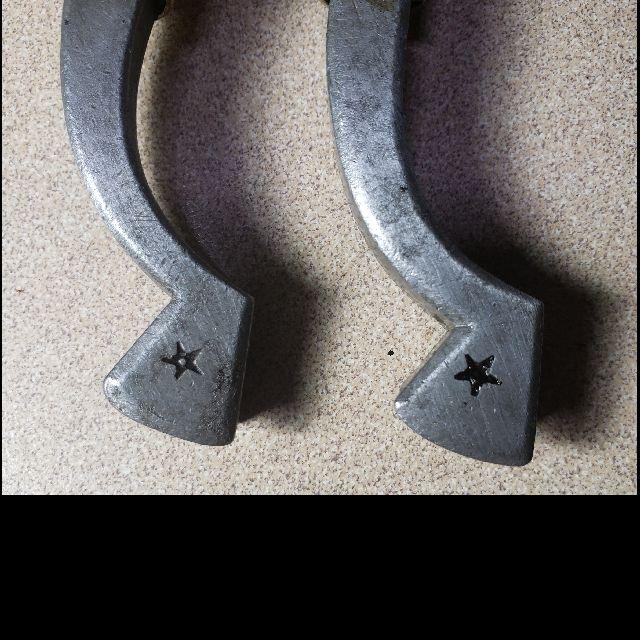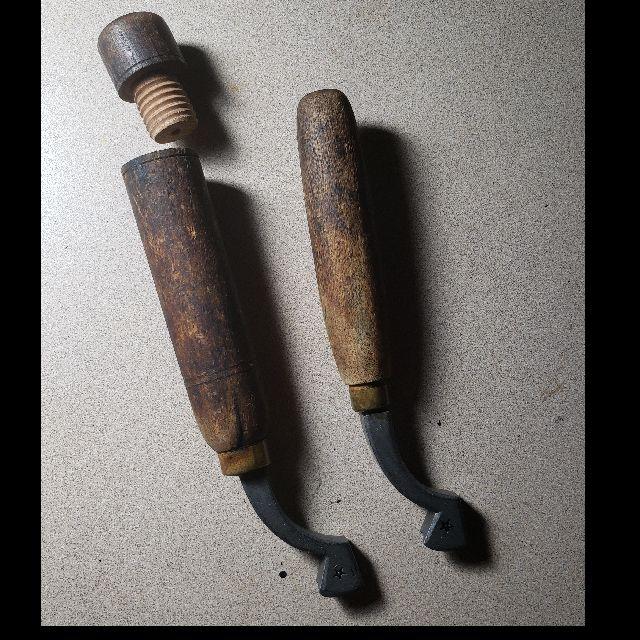-
Posts
1,282 -
Joined
Content Type
Profiles
Forums
Events
Blogs
Gallery
Everything posted by SUP
-

Dye Rubbing Off
SUP replied to rktaylor's topic in Dyes, Antiques, Stains, Glues, Waxes, Finishes and Conditioners.
Try a coat of petroleum jelly. Apply and buff off a couple of times. It makes leather pretty water-proof and is the main ingredient of Aussie's leather conditioner which so many swear by. It is probably perspiration which dampens the leather and causes the dye to rub off, in which case this might help. Check this thread for more information about petroleum jelly/Vaseline. -
I just realized today, that in earlier times, oak gall ink was made by soaking powdered oak gall in water while also, in a different utensil, soaking old iron nails etc. in Vinegar. Both liquids were then strained separately and mixed to make the ink. No different from the reaction that leatherworkers use to dye leather black with Vinegaroon. I know the same reaction can be used on wood too. So that is two completely different ways the same reaction was used - as an ink and as a dye. I wonder if there were others.
-

Dye Rubbing Off
SUP replied to rktaylor's topic in Dyes, Antiques, Stains, Glues, Waxes, Finishes and Conditioners.
Immediately after dyeing and drying completely, before any further treatment, you needed to buff the liner until no more dye came off on the buffer. An old clean T-shirt works for this. The buffing removes the excess dye. Right now, if the dye comes off, buffing might still work. You can follow that up with Neatlac or diluted Resolene in several coats. Buff in between coats so that if the coating affects the dye in any way, you are taking it off. Allow to dry before buffing. -
One way would be to decrease the tannins by using washing soda or tannin cleanser on the leather first before treating with Vinegaroon, since tannins are needed to get a deep black color. Another way would be to make a new batch with very little iron added, so that the Vinegaroon will be very dilute. Try it every few hours on scrap leather until you get the shade that you need.
-
Oops. You caught me. Good idea about the dropper bottle though.
-
Oh. Okay. I'm lazy, I'm afraid. So I'll stick to the wax block until someone enterprising, like you () comes up with a good recipe for making that wax in a bottle and shares it. However, if I don't use the wax block, I have the headache of needing to cut more splits, more frequently. Melting and hardening wax is infinitely easier than doing that. It also is the safest for the tips of my chisels. I have never ever punched right through the wax block.
-
@toxo why noy make a brick of coad and rub that along the stitching line or run your thread through it before stitching? You can make it as hard or soft or sticky as you like. Punching on wax helps the chisel slip out of the leather easier. Coad on thread might help as well, getting onto the 2nd needle through a stitching hole, the first going through a clean hole and pulling the waxed thread behind it, and waxing the stitching hole enough to wax the 2nd needle. This site has plenty of information on coad, only not easily available right now as the site recovers from last week's hack attack. You could buy it but where' the fun in that? Search on google for 'coad wax' though and the first item you see is the thread on this site from 2016, with a good recipe.
-
@Sheilajeanne Oops! I remember it was @fredk But I thought there was a second person who mentioned it too and I thought it was you. Maybe I'm wrong and I got some other idea from two people...... Anyway, It is very convenient. Great idea @fredk. Thank you for sharing. I use it all the time. Sometimes I also use thick pads of leather splits. I got a few from Springfield Leather that are very thick. I flatten them and cut them to different sizes as I need. They work well. As they get holey, they get a bit limp and I discard them. They are inexpensive and easy to make. I use these for the thinner leathers. Mainly though, I user well waxed thread - was looking up making coad today. Fun to do and I can wax my thread to the extent that I want. I do not much like Ritza... I know that goes against popular opinion but it appears to be too much a price for a product that I do not think is worth it. They also do not have as many colors as I would like. But then, maybe it is needed for the items that I do not make.
-
Yes, I do the same. I use plain Tokonole. Sometimes I dilute it a little so that the original color of the leather is visible.
-
Chrome tanned leather cannot be burnished like Veg tanned leather, to a gorgeous, homogenous shine but it can be burnished to a point where it does not look like a raw, unfinished edge.
-
I gave in and bought a prototype. I received it yesterday. It is small but very light and surprisingly easy to work with. Not yet used it on chrome tanned leather but will, sometime this week. I will update this post after that.
-
Wow! That looks appealing and fits so well in your hand. I'm sure it makes working with it much more comfortable! And love that handle.
-
That solves the problem the best, I should think.
-
@dikman yes I have heard of that. So not bought it any time, even when recommended. But this time, I think I will. And take care to not give the rags a chance to combust. I will probably use just one rag and dry it out thoroughly, spread out, as suggested.
-
What a lovely idea. And those bags are beautiful!
-
The tips are perfect actually. I can use them even now. But I want to take care of them first. So BLO and putty it is. Thank you for guiding me on what to do.
-
Hmm. Some lemon pledge! I washed it and scrubbed it to get rid of layers of grime. Any lemon pledge or anything else is long washed off. I read about it - lemon wood retains a mild scent for years and is noticed sometimes when the wood is wet. it disappear when it dries. @Beehive do you mean that I should rub it with BLO daily for a week, after an initial soak for a few minutes? I can do that. What about the crack? Can I fill it up now or after the BLO treatment? And staining? Sorry. I'm not a wood worker. Just pick up stuff as I go.
-
The wood seems to be lemon wood. I had to wash both handles because they were very grimy and when examining them closely, I realized that they smell of lemon.
-
@Johanna clearly, many here feel that the older appearance was warmer. Blue is an inherently cool color, so maybe , if you could just change the theme color to warmer ones, it might make a difference. You do not need to change the whole appearance while other, more vital things are being done, but just changing the theme color maybe?
-
I know but like the tools looking old. I like the patina. I have cleaned them to remove all the grime and rust. I do not plan to do much more to the metal other than oiling them lightly. The wood, I have cleaned as well. Maybe some putty to fill the crack and prevent further damage. Then some stain, my oils and conditioners. I want them to look well cared for, not brand new. These tools have 'lived' and should show that experience, albeit in a gentle way. I probably sound a bit ditzy when I say that but that is how I feel. I had not thought of that but that is a real possibility. I did not even notice it until I was scrubbing it and happened to twist the base. I plan to check all my old tools to see if any of them have the same. When I can, I will continue to search for information on that Star logo. Not found it yet but I am probably using the wrong search string. I hope someone here can give me some information on it.
-
This is how the stars appear. The tools are obviously old but I do not know how old. Could anyone guide me about this please? This website is still not fully recovered so search results did not give me anything. Edit: It looks like the star on Osborne knives, so is it an old Osborne? @bruce johnson has explained sometime in 2014 that Osborne added the star logo sometime in the late 1800s but not clear if the star appeared by itself without any words whatsoever. I expected at least the name and size to be present but I cannot find either. (As this site recovers, earlier information becomes available. Hurray!) Anyway, it would be interesting to know.
-
I found a couple of edge creasers with only a star on them. No name or even size shown. The handle opens up on one of them. It unscrews open and is empty inside. I'll put up some pics as soon as I can. Does anyone know which company that could be?
-

Glue and vapor permeability
SUP replied to Eelco's topic in Dyes, Antiques, Stains, Glues, Waxes, Finishes and Conditioners.
Oh Goody! I like that. Scientific information and explanations. Does it dissolve into the leather fibers? I should think it will only diffuse along the fibers. That is why we use waxes and other material which will not allow that, to water proof footwear, is it not? Wax being hydrophobic, technically allows water vapor to diffuse through, but in such small amounts that it is even used to seal food. So it should be minimal. In PVAc too, the water molecules move through between the polymer chains, in a similar manner, I believe. Sorry, I stopped reading after that because I am not really interested in synthetic materials, but thank you. If I ever need it, I will know to read this before using anything synthetic. And leather and pores. Saying leather is porous does not mean that there are tiny pores, like open channels on the surface, is what I meant. Unfortunately, many people do think that, like they think about our skin with pores that open and shut like windowpanes! Nothing like that. It just means that there are spaces in between the fibers through which water molecules can move. What we see as pores on the surface of leather is actually the points where hair follicles were. They are, fortunately or unfortunately, not little corridors from one side to the other. If only they were. That would make stitching so much easier. No need to use stitching chisels; just widen the 'pores' with an awl, like doing so when using pricking chisels! But I digress. This is about moisture permeability in leather and breathability. It can be used in a sensible way to achieve what we want. I use deerskin moccasins that I made for indoor use. The soles have a synthetic midsole and the outer and inner soles are both deerskin. I like to use a generic Gorilla glue for all my leatherwork. It is easy to use, dries to the color of wood, which is never visible anyway and is pretty strong. Are the soles permeable to moisture? Maybe, maybe not. But the rest of the shoe certainly is. The upper and the sides are all a single layer of deerskin and my feet are always dry. All through the hot summers here the moccasins get wet often but my feet remain dry. The moccasins dry as rapidly as well. I have never had an issue with moist or damp feet. So this means that the soles do not need to be permeable to moisture, which is a good thing. Like anyone who has a pet knows, accidents happen and I would not like to be wearing moisture permeable footwear when I discover one by stepping into it! So, my moccasins are certainly breathable, in a practical way. As long as there is a path for the water vapor to evaporate, the sides and top work as well because I am always moving and the water vapor molecules move as well... and evaporate. After all, water vapor rises anyway, so it will gradually come to the top of my feet and then evaporate through the deerskin upper. They keep my feet dry, the soles are soft and I do not step into pet accidents. And they are certainly far, far more comfortable than any synthetic material, or indeed, any store bought leather footwear too.. And if I want the 'earthing' experience, I do what I did as I was growing up - walk around at home barefoot; during the day, in bright light. You have provided some really interesting information. While I, being a scientist, albeit in Biology, understand, perhaps you could express the same information in layman's terms so that everyone can understand. e.g. instead of hydrophilic, saying 'water repelling' will make things more clear; the difference between diffuse and dissolve, what permeable means and so on. Thank you again for all the information. Coming to this site is always a learning experience and quite delightful. -

Glue and vapor permeability
SUP replied to Eelco's topic in Dyes, Antiques, Stains, Glues, Waxes, Finishes and Conditioners.
If air and moisture go in and out, it means that water can as well. So leather is either water resistant or breathable. Or, the leather does not absorb water but it lets the water in, through the 'pores' that people seem to be talking about online everywhere. So your shoes are safe but your feet are wet but will dry because of those very same 'pores'. Or am I getting everything wrong @Eelco? Of course, for indoor use, this should not be a problem.




